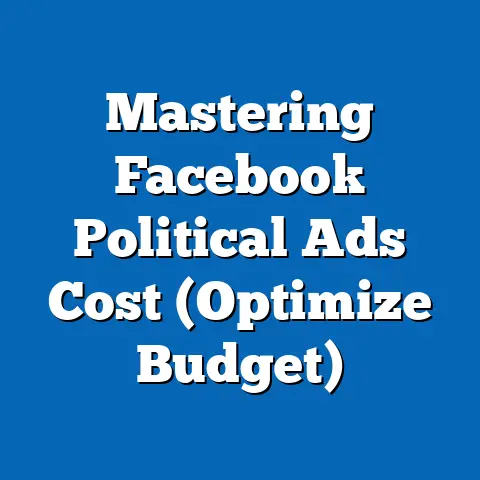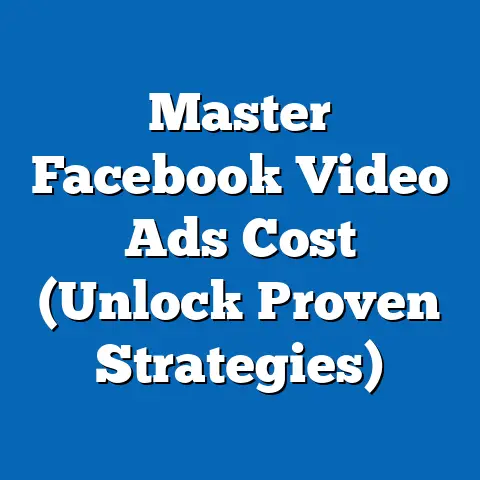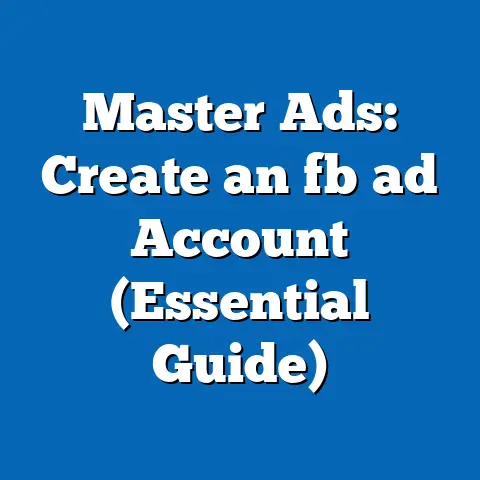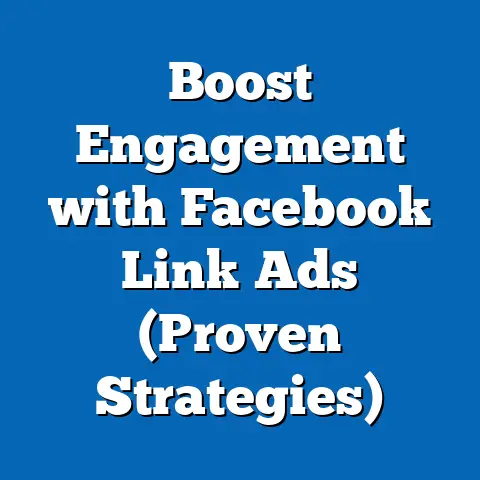Boost Small Business with Facebook Ads (Proven Strategies)
The digital landscape is constantly evolving, but one thing remains constant: the spirit and resilience of small businesses. I’ve witnessed firsthand how these businesses adapt, innovate, and find creative ways to thrive in a world that’s increasingly online. They embrace new technologies, learn new skills, and aren’t afraid to experiment. And one tool that has proven its durability and continues to evolve alongside them is Facebook.
Facebook, despite the rise of newer platforms, remains a powerhouse for reaching potential customers. It’s not just about having a page; it’s about strategically leveraging Facebook ads. Why? Because Facebook ads offer unparalleled targeting capabilities, allowing you to pinpoint your ideal customer with laser precision. They’re also surprisingly cost-effective, especially when compared to traditional advertising methods. And, perhaps most importantly, they’re measurable. You can track your results, analyze your data, and refine your campaigns to maximize your ROI.
In this article, I’m going to share some proven strategies that small businesses can use to boost their growth with Facebook ads. I’ve seen these strategies work firsthand, helping businesses of all shapes and sizes achieve their marketing goals. So, let’s dive in and explore how you can unlock the power of Facebook advertising for your small business.
Understanding Facebook Ads
Before we jump into the strategies, let’s make sure we’re all on the same page about what Facebook ads are and how they function. Simply put, Facebook ads are paid messages that businesses can display to users on Facebook and Instagram (since Facebook owns Instagram). These ads can take various forms, including:
- Image Ads: A single image with accompanying text. These are simple, yet effective for visually appealing products or services.
- Video Ads: Engaging video content that captures attention and tells a story. Video ads can be short and sweet or longer, more in-depth pieces.
- Carousel Ads: Allow users to scroll through multiple images or videos in a single ad. This is great for showcasing different features of a product or telling a narrative.
- Collection Ads: Designed for mobile shopping, these ads feature a hero image or video followed by a selection of related products.
- Instant Experience Ads: Full-screen, mobile-optimized experiences that open when someone clicks on your ad. These can be used to showcase products, tell stories, or encourage engagement.
- Lead Ads: Specifically designed to collect leads directly within Facebook. These ads make it easy for people to sign up for newsletters, request quotes, or download resources.
The real magic of Facebook ads lies in the Facebook Ads Manager. This is your central hub for creating, managing, and analyzing your campaigns. Within Ads Manager, you can:
- Choose your campaign objective (e.g., awareness, traffic, engagement, leads, sales).
- Define your target audience based on demographics, interests, behaviors, and more.
- Set your budget and schedule.
- Design your ad creatives.
- Track your performance and make adjustments.
Audience targeting is arguably the most powerful aspect of Facebook advertising. You can target people based on:
- Demographics: Age, gender, location, education, job title, etc.
- Interests: Hobbies, passions, and things they’ve expressed interest in on Facebook.
- Behaviors: Past purchases, online activity, and other behaviors that indicate their likelihood to be interested in your product or service.
- Custom Audiences: Uploading your own customer lists (email addresses, phone numbers) to target existing customers or create lookalike audiences.
- Lookalike Audiences: Reaching new people who share similar characteristics with your existing customers.
Key Takeaway: Facebook ads come in various formats, each with its strengths. The Facebook Ads Manager is your control panel, and audience targeting is the key to reaching the right people with the right message.
Proven Strategies to Boost Your Small Business
Now, let’s get to the heart of the matter: the strategies that can actually help your small business thrive with Facebook ads. These aren’t just theoretical concepts; they’re strategies I’ve personally seen deliver results for businesses of all sizes.
Strategy 1: Define Your Target Audience
Creating detailed buyer personas is a crucial step. A buyer persona is a semi-fictional representation of your ideal customer based on research and data about your existing customers and target market. It goes beyond basic demographics and delves into their motivations, goals, and challenges.
Here’s an example:
- Name: Sarah Miller
- Age: 35
- Occupation: Marketing Manager
- Location: Austin, Texas
- Income: \$75,000
- Goals: To increase brand awareness and generate leads for her company.
- Challenges: Limited budget, difficulty tracking ROI, staying up-to-date with the latest marketing trends.
- Interests: Digital marketing, social media, technology, entrepreneurship.
- Online Behavior: Spends time on LinkedIn, Facebook, and Twitter. Reads marketing blogs and attends industry webinars.
Once you have a clear picture of your ideal customer, you can use Facebook Insights to gather even more data. Facebook Insights provides valuable information about your audience, including their demographics, interests, and behaviors. You can use this data to refine your targeting and ensure that your ads are reaching the right people.
I remember working with a local bakery that was struggling to attract new customers. They thought their target audience was “everyone in the neighborhood.” But after digging into Facebook Insights, we discovered that their most engaged customers were women aged 25-45 who were interested in baking, healthy eating, and local businesses. This insight allowed us to create targeted ads that resonated with this specific audience, resulting in a significant increase in sales.
Key Takeaway: Don’t guess who your target audience is. Do your research, create detailed buyer personas, and use Facebook Insights to gather valuable data.
Strategy 2: Create Compelling Ad Content
Once you know who you’re targeting, you need to create ad content that grabs their attention and compels them to take action. This means crafting a strong headline, using engaging visuals, and including a clear call-to-action.
Here are some key elements of successful ad copy:
- A strong headline: Your headline is the first thing people will see, so it needs to be attention-grabbing and relevant to your target audience. Use keywords that they’re likely to search for and highlight the benefits of your product or service.
- Engaging visuals: Images and videos are crucial for capturing attention on Facebook. Use high-quality visuals that are relevant to your ad copy and appeal to your target audience. Consider using images of people using your product or service, or videos that showcase its features and benefits.
- A clear call-to-action: Tell people exactly what you want them to do. Use clear and concise language, such as “Shop Now,” “Learn More,” “Sign Up Today,” or “Get a Free Quote.”
Let’s look at some examples of effective ad content from successful small businesses:
Key Takeaway: Create compelling ad content that grabs attention, tells a story, and includes a clear call-to-action. Use high-quality visuals and focus on the benefits of your product or service.
Strategy 3: Utilize Retargeting
Retargeting is one of the most powerful strategies for boosting conversions on Facebook. It involves showing ads to people who have already interacted with your business in some way, such as visiting your website, watching a video, or engaging with your Facebook page.
Why is retargeting so effective? Because these people are already familiar with your brand and have shown some level of interest in your products or services. They’re much more likely to convert than someone who has never heard of you before.
Here’s how retargeting works on Facebook:
- Install the Facebook Pixel on your website: The Facebook Pixel is a small piece of code that tracks visitors to your website and their actions.
- Create custom audiences based on website visitors: You can create custom audiences based on people who have visited specific pages on your website, spent a certain amount of time on your website, or taken specific actions, such as adding items to their cart.
- Create retargeting ads that are relevant to their past behavior: Show them ads for the products they viewed on your website, or offer them a discount to encourage them to complete their purchase.
For example, if someone visits your website and views a specific product, you can show them a retargeting ad for that product on Facebook. Or, if someone adds an item to their cart but doesn’t complete the purchase, you can show them a retargeting ad offering them free shipping or a discount to encourage them to complete their order.
I once worked with an e-commerce store that was struggling with abandoned carts. By implementing retargeting ads, they were able to recover a significant percentage of those abandoned carts and increase their sales by 20%.
Key Takeaway: Retargeting is a powerful strategy for boosting conversions. Show ads to people who have already interacted with your business and offer them incentives to take the next step.
Strategy 4: Leverage Lookalike Audiences
Lookalike audiences are a great way to reach new people who are likely to be interested in your business. They allow you to create audiences that are similar to your existing customers, based on their demographics, interests, and behaviors.
Here’s how to create a lookalike audience on Facebook:
- Create a source audience: This is the audience that Facebook will use to find similar people. You can use your existing customer list, website visitors, or Facebook page fans as your source audience.
- Choose the lookalike audience size: This determines how closely the lookalike audience will resemble your source audience. A smaller audience will be more similar to your source audience, while a larger audience will be less similar.
- Create your lookalike audience: Facebook will then use its algorithm to find people who share similar characteristics with your source audience.
The benefits of using lookalike audiences are:
- Reach new potential customers: Expand your reach beyond your existing customer base.
- Target people who are likely to be interested in your business: Increase the relevance of your ads and improve your conversion rates.
- Save time and effort: Avoid the need to manually target your ads based on demographics and interests.
I’ve seen lookalike audiences work wonders for businesses that are looking to scale their advertising efforts. By leveraging the power of Facebook’s algorithm, you can reach new customers who are highly likely to be interested in your products or services.
Key Takeaway: Lookalike audiences are a powerful tool for reaching new potential customers. Create lookalike audiences based on your existing customers and expand your reach beyond your current customer base.
Strategy 5: Optimize for Conversions
Ultimately, the goal of Facebook advertising is to drive conversions, whether that’s sales, leads, or other desired actions. To optimize your campaigns for conversions, you need to track your results and make data-driven decisions.
Conversion tracking is essential for understanding how your ads are performing and identifying areas for improvement. You can use the Facebook Pixel to track conversions on your website, such as purchases, sign-ups, and form submissions.
Here are some tips on optimizing your ad campaigns for better conversion rates:
- A/B test your ad creatives: Test different headlines, images, and call-to-actions to see what resonates best with your target audience.
- Adjust your bidding strategies: Experiment with different bidding strategies to see which one delivers the best results for your budget.
- Optimize your landing pages: Ensure that your landing pages are relevant to your ad copy and make it easy for people to convert.
- Target the right audience: Use Facebook’s targeting options to reach people who are most likely to be interested in your product or service.
- Monitor your results and make adjustments: Continuously track your performance and make adjustments to your campaigns based on the data.
I remember working with a local restaurant that was struggling to generate online orders. By implementing conversion tracking and A/B testing their ad creatives, they were able to significantly improve their conversion rates and increase their online orders by 30%.
Key Takeaway: Conversion tracking is essential for understanding how your ads are performing. A/B test your ad creatives, adjust your bidding strategies, and optimize your landing pages to improve your conversion rates.
Measuring Success and Making Adjustments
Once your campaigns are up and running, it’s crucial to monitor your results and make adjustments as needed. This is an ongoing process, as Facebook’s algorithm and user behavior are constantly changing.
Here are some key metrics that small business owners should monitor to gauge the success of their Facebook ads:
- Click-Through Rate (CTR): The percentage of people who see your ad and click on it. A high CTR indicates that your ad is relevant and engaging to your target audience.
- Conversion Rate: The percentage of people who click on your ad and complete a desired action, such as making a purchase or filling out a form. A high conversion rate indicates that your ad is effective at driving conversions.
- Cost Per Click (CPC): The amount you pay each time someone clicks on your ad. A low CPC indicates that your ad is efficient and cost-effective.
- Cost Per Conversion (CPC): The amount you pay for each conversion. A low CPA indicates that your ad is effective at driving conversions at a reasonable cost.
- Return on Ad Spend (ROAS): The amount of revenue you generate for every dollar you spend on advertising. A high ROAS indicates that your ad is generating a positive return on investment.
By monitoring these metrics, you can identify areas where your campaigns are performing well and areas where they need improvement. For example, if your CTR is low, you may need to revise your ad copy or visuals. If your conversion rate is low, you may need to optimize your landing pages or adjust your targeting.
I always advise my clients to view Facebook advertising as a long-term investment. It takes time and effort to refine your strategies and achieve consistent results. Don’t be afraid to experiment, test new ideas, and learn from your mistakes.
Key Takeaway: Monitor your results and make data-driven decisions to improve ad performance. View Facebook advertising as a long-term investment and be prepared to test, iterate, and refine your strategies over time.
Conclusion
Facebook ads offer a powerful opportunity for small businesses to reach new customers, drive growth, and achieve their marketing goals. By implementing the strategies discussed in this article, you can effectively harness the power of Facebook advertising and unlock its full potential.
Remember, the key to success is to define your target audience, create compelling ad content, utilize retargeting, leverage lookalike audiences, and optimize for conversions. And, most importantly, monitor your results and make data-driven decisions to improve your ad performance over time.
Don’t be afraid to experiment, test new ideas, and learn from your mistakes. With the right strategies and a little bit of patience, you can achieve remarkable results with Facebook ads and take your small business to the next level.
Call to Action:
I’d love to hear about your experiences with Facebook ads! Share your thoughts, questions, and success stories in the comments section below. And don’t forget to follow my page for more insights on digital marketing for small businesses. Let’s work together to help your business thrive in the digital age!






